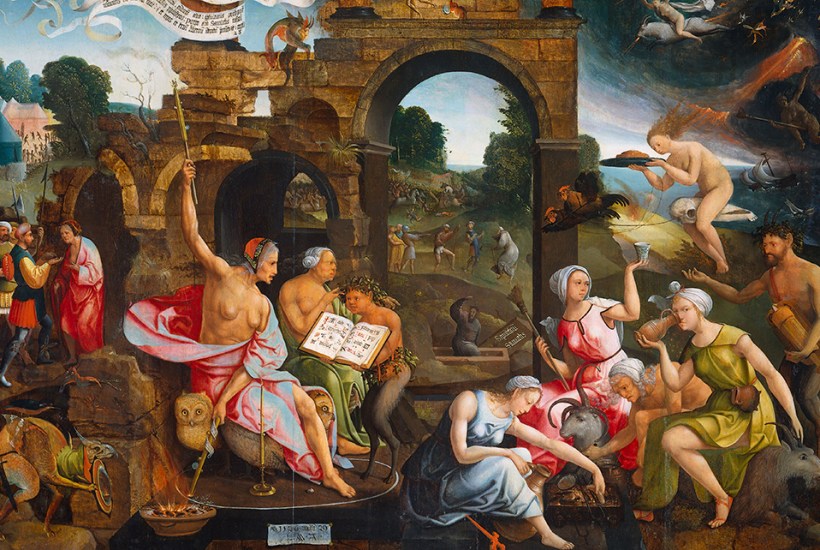Curses, conjurations, magic circles, incantations, abracadabra, gobbledygook… Why would any serious historian want to write a history of magic books?
Owen Davies issues a robust defence: magic is as old as human history, while a study of grimoires is a study of the book itself and its changing format over time. Through the lens of the grimoire (a book of magic spells and invocations), the parallel histories of religion and science are shown in an eerie new light. Perennial human desires, anxieties and aspirations for love, money and protection from harm bring people of the far past close to anyone today who reads a newspaper horoscope or consults the Tarot. At the very least, magic books continue to cast their spell over popular culture in countless films, novels, games and across the internet.
A professor of social history and the president of the Folklore Society, Davies has form. In 2009, his Grimoires: A History of Magic Books was published byOxford University Press, an entertaining yet scholarly title printed on indifferent paper with a limited, monochrome plate section. Art of the Grimoire could be seen as the coffee-table version with vastly expanded, colour plates and boiled-down text. It’s a far more beautiful production: a typographic and calligraphic treat as treasurable as a rare magical text itself. Almost every page is filled with wonder.
Davies begins his account with Sumerian clay tablets inscribed with protective formulae against sickness, demons and ghosts. Magic and medicine were not yet separate disciplines. Stone stelae inscribed with appeals to the gods were used in practical magic: water poured over the inscriptions was then drunk for health and good luck. Later, Neolithic axes were inscribed with spirits’ names, clay pots were decorated with demonic images, threatening boundary stones warned off intruders, soldiers scratched curses on lead tablets, while the wealthy sported gold amulets. The Chinese scratched their appeals on oracle bones and slips of bamboo. With papyrus, however, the potential of the magical text was vastly expanded and many examples from ancient Egypt survive. (At a later point in the story, this fabled wisdom of Africa was to provide solace to the descendants of slaves.)
Syncretism makes an appearance early on, perhaps because occult lore always gains more power by seeming to originate from some exotic source. A stunning 5th-6th century amulet in green jasper features an Egyptian cock-headed god with snake legs wearing Roman dress, below the names of the archangels Raphael and Gabriel. A papyrus scroll written in Greek contains a variety of spells: ‘To induce insomnia by means of a bat, win at dice, stop demons and apparitions, silence others, and provoke love.’ (Davies’s dry captions are a regular a delight.)
Though Davies wanders the globe in his survey, taking in Coptic charms, Islamic angels and jinns, yokai (Japanese demons), Hebraic and Arabic texts, the term ‘grimoire’ to most people invokes western mages such as John Dee and Doctor Faustus – whose final, despairing cry in Marlowe’s play of the same name is: ‘I’ll burn my books.’ Parchment heralds the arrival of the true grimoire. Davies presents impressive examples from illuminated manuscripts: a red-winged angel leading a man away from a bird-footed devil; intricate magical seals; carefully lettered talismans. The advent of printing, like that of the internet, democratised hidden lore, raising fears of the dissemination of dangerous material. Cornelius Agrippa’s De Occulta Philosophia deplored ‘commerces of unclean spirits’ and ‘unlawfull charms’, but nonetheless provided useful details of sigils, kabbalah and angel magic.
The theme of repackaging recurs throughout Art of the Grimoire. Books promising revelations of ‘ancient wisdom’ are patchworks of old material with new inserts, frequently and wrongly ascribed to canonical authors such as Agrippa. ‘It is their falsity that makes them genuine,’ Davies remarked in his earlier book, citing the ‘bogus traditions that cling to real grimoires’. A book could become a grimoire against its author’s sworn intention. Reginald Scot’s The Discoverie of Witchcraft (1584) purported to deplore conjuration, yet included material such as the depiction of an elaborate magic circle to be marked out on the ground with the names of five infernal spirit kings, thus making his text a valuable magical sourcebook.
Sensational texts whipped up a widespread terror of the occult that led directly to witch trials throughout Europe, and ‘white’ magic was as offensive to the authorities as the more malevolent type. ‘The object of focus of these early demonologists was not male magicians and learned necromancers with their manuscript grimoires, but poor women,’ Davies observes tartly. A crude 16th-century ink drawing shows three Swiss witches bound and laid on a pyre. Equally calm, a supposed werewolf from Geneva exhibits a surprisingly patient demeanour while chunks are torn from its flesh with red-hot pincers.
Lack of literacy tended to bar women from text-based magic. However, an early visual link between lascivious witches and books is made by a Netherlandish painting of 1526, ‘Saul and the Witch of Endor’, with its semi-naked crone consulting a volume held by a satyr, along with more familiar images of women flying on broomsticks. With cheap printing, spellbooks containing crude woodcuts of demons began to circulate widely, while alchemical texts appealed to loftier readers. A typically esoteric example features a ‘divine hermaphrodite’, a snake, chalice and trees of the sun and moon. The surrealist painter Leonora Carrington was to draw deeply on this tradition in the 20th century.
The rational Enlightenment had its counter-current in occult studies, with London as a key base for practitioners. Davies reproduces a drawing of three jovial ginger demons from Francis Barrett’s influential The Magus of 1801, a volume which fed into the development of ritual magic later in the century, despite containing little original material. A coloured talisman from the book has distinct Hilma af Klint energy. The life of Barrett is more fully told in Davies’s earlier book. He was an enterprising, if not overly successful, balloonist.
A later character to match Barrett was the American huckster Lauron William de Laurence, who began as a plagiarist and posed as a swami. Other self-presentations took on the Egyptian flavour that appealed to the movement for African-American empowerment. Laurence’s catalogue of occult paraphernalia became a book of magic in its own right.
Davies has an entertaining chapter on the explosion of occult material occasioned by the advent of ‘pulp’ publishing. Again, new technology advances magic rather than wiping it out. Davies touches on post-colonial schlock such as the St Cyprian paperbacks of South America, and print advertisements offering impoverished Americans ‘Ancient Knowledge’ and ‘Esoteric Treasure’ for a few dollars. ‘Purchasers must have been very disappointed with their $3 spend,’ Davies sniffs of one rip-off pamphlet.
Final chapters deal briefly but suggestively with modern magical trends: downloadable spells, multimedia artworks, automatically generated sigils, manga and anime, Harry Potter, and TV shows, such as Charmed from the 1990s with its prop Book of Shadows. While much magical activity has now migrated online, Davies asserts that manuscripts and hand-copying retain their intrinsic power, with modern-day grimoires akin to personal records of self-improvement. The full panoply of pseudo-scripts, grids, mystic symbols and infernal portraiture feeds into works of contemporary art. It seems that grimoires, far from being consigned to medieval darkness, aren’t going anywhere.
Got something to add? Join the discussion and comment below.
Get 10 issues for just $10
Subscribe to The Spectator Australia today for the next 10 magazine issues, plus full online access, for just $10.
You might disagree with half of it, but you’ll enjoy reading all of it. Try your first month for free, then just $2 a week for the remainder of your first year.














Comments
Don't miss out
Join the conversation with other Spectator Australia readers. Subscribe to leave a comment.
SUBSCRIBEAlready a subscriber? Log in